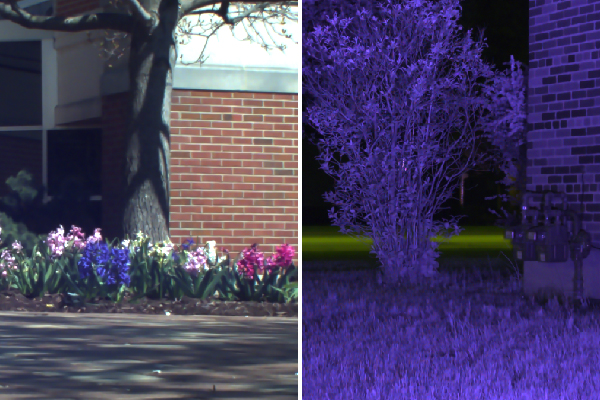News

UD researchers take step toward eliminating need for separate devices for day, night cameras
Cell phones, cars and many other devices have separate cameras and sensors for day and night vision, but that need could go away thanks to University of Dayton researchers who developed a single device that can switch between day and night vision applications.
The journal Optics Express published the researchers' tunable filter work last month.
UD electro-optics graduate student Remona Heenkenda designed and fabricated the optical filter under the guidance of UD electro-optics professor Andrew Sarangan and computer engineering professor Keigo Hirakawa.
Sarangan and Hirakawa said it ultimately would be up to manufacturers to implement these sensors and cameras into their devices, but they see a valuable practical application in reducing the number of cameras and sensors in smartphones and cars, which could reduce cost and increase night safety.
In the optical filter Heenkenda developed, a new material known as phase change material switches the camera between day and night operation. This optical filter can be switched on and off using very small heat pulses, according to Sarangan. The same type of materials also are used to store data in some computer chips, Sarangan added.
"At night, we want the camera to see better by allowing near infrared light. During the day, near infrared makes colors funky, so we want to block it from the camera," Hirakawa said. "So we need to filter out near infrared only during the day. Our switchable filter uses phase changes to block or pass near infrared light to the camera." Optimization, he added, would be automated switching based on the filter recognizing night by clock or the amount of light.
"Cars are going to be sensors on wheels. It's headed that way," Hirakawa said. “If you can recycle technology to do two things, and you can save a nickel or dime per 100 million parts, you can save $10 million. If you can cut costs and redundancies in your camera or your devices, then it can potentially be very, very helpful. In automotive, this will be something in all cars, not just luxury cars, because the savings makes it accessible for everyone."
As a doctoral student working with Sarangan, Heenkenda also presented at the Institute of Electrical and Electronics Engineers Photonics conference in 2021. She said she is thankful for the opportunities she gets as a student at UD.
"There are only a handful of electro-optics and photonics graduate programs in the country and University of Dayton is one of them with access to cutting-edge research facilities such as nanofabrication laboratories," Heenkenda said. "We are privileged to work with distinguished professors doing research with industry, thereby consistently staying up-to-date with the latest research trends. These collaborations open many opportunities for students to gain invaluable experience preparing them for the future."
For interviews, contact Shawn Robinson, associate director of news and communications, at srobinson1@udayton.edu.
Photo caption: The photo on the left was taken with the filter in the "day" setting. Using the same camera, the photo on the right was taken under infrared illumination with the filter in the "night" setting.
